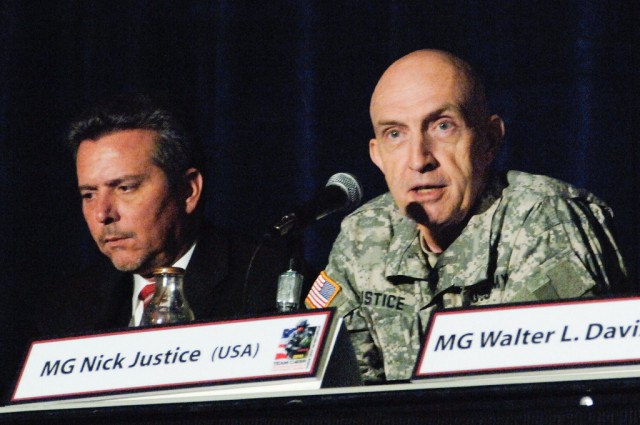BALTIMORE -- What Soldiers need to be successful on the battlefield and how the technology should be developed were questions the Army and industry met to talk about during Panel Session One at the Team C4ISR Symposium in Baltimore recently.
Technology is changing so fast, and the acquisition process traditionally has been so slow, the topic raises more challenges than solutions at present.
The Army C4ISR concept, or "Command, Control, Communications, Computers, Intelligence, Surveillance and Reconnaissance," supports Soldiers fighting every day, upgrading and modernizing existing systems, incorporating new technologies, and ensuring the operational readiness of these systems that both protect our warfighters and give them a technological advantage over the enemy.
During the three-day annual symposium, Army leadership appealed to industry.
"We don't want to buy infrastructure that will hold us back," said Maj. Gen. Nick Justice, U.S. Army Research, Development and Engineering Command commanding general, to the crowd of 300-400 symposium attendees. "We need an infrastructure that we can modernize in increments to stay abreast of changes in technology."
Justice, who participated on the warfighter requirements panel with other Army leadership experts, reinforced messages that the latest technology, for technology's sake, does not necessarily increase the warfighter's capability. In fact, the platform and training requirements that come with new technology can be a hindrance.
"We need to do more without more," said Lt. Gen. Bill Phillips, military deputy to the Assistant Secretary of the Army for Acquisition, Logistics and Technology, and the senior ranking Army officer at the symposium this morning. Phillips is referring to the Office of the Secretary of Defense Efficiencies Initiative he is supporting that will ensure weapons and other infrastructure systems are clearly needed, relevant today and tomorrow, efficient, effective, affordable and executable.
"'Better' is the enemy of good enough," Phillips said. "Reaching for the stars causes us to fail in meeting our current requirements."
On the top of the list of systems the warfighter needs is a more extensive communications network.
The Army Enterprise Architecture of the network is the domain of Maj. Gen. Mark Bowman, director of Architecture, Operations, Networks and Space at the Office of the Chief Information Officer/G6. Bowman also was the moderator of the panel session.
Bowman said modularity is foundational to modernizing the communications network, but "applying the approach is the challenge."
Developing, testing and fielding new modules are a focus for the Army right now, and it is looking ahead not only for itself, but also for the other services.
"We're working toward one network, one team," said Bowman. To get this done, the military services are looking together at establishing common requirements and standards, which he sees as the biggest challenge to meeting the warfighter need for a more extensive communications network.
Justice also expressed his thoughts in response to the question about what the Army's biggest challenge is in meeting warfighter requirements. In his view this is the speed of implementing new technology and getting it into the warfighter's hands.
"We're focusing on the wrong thing," he said. What is important to him is not that warfighters have the latest technology, but that they have the capability they need to do their jobs. It's not reasonable, he says, with the speed at which technology is changing today to expect the Army to be "clairvoyant" in projecting what will be available in the future in order to plan for it now.
"We need to be less risk averse," said Justice regarding testing the much needed warfighter Information Network - Tactical capability, with applause from the industry audience. "Let's try it and get it out there."


Social Sharing